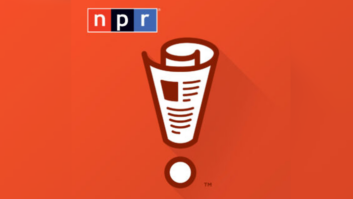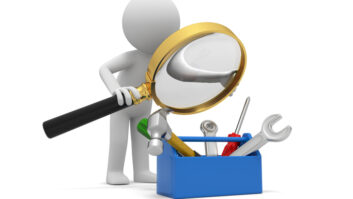The witty news quiz show “Wait Wait … Don’t Tell Me!” from NPR and WBEZ was first broadcast from Chicago on Jan. 3, 1998. It originally was assembled with content from NPR studios in Chicago, Washington and other locations as needed, until settling in for many years at Chicago’s Chase Auditorium.
“Wait Wait” continued undaunted during the pandemic, when productions from Chase were replaced by Zoom meetings from the homes of host Peter Sagal, the show’s panelists and audience participants.
Today, “Wait Wait” is back before a live audience at Chicago’s Studebaker Theater and in venues across America.
In December 2023, the New York Section of the Audio Engineering Society hosted an event at Mercy University, providing a look behind the scenes of the show. AES Fellow David Bialik hosted “Wait Wait” Technical Director Lorna White and Production Manager Robert Neuhaus.
The “Wait Wait” website states that White “began working at NPR in 1984 as a child” and that she was assigned to the show “when she was old enough to tell fart jokes.” And it says that Neuhaus “has spent a lifetime creating funny noises and helping other people hear them” and that for NPR “he has recorded everything from important politicians to squealing hogs, and still manages to tell the difference.”
Here’s a sampling of the AES talk and a link to a video archive.
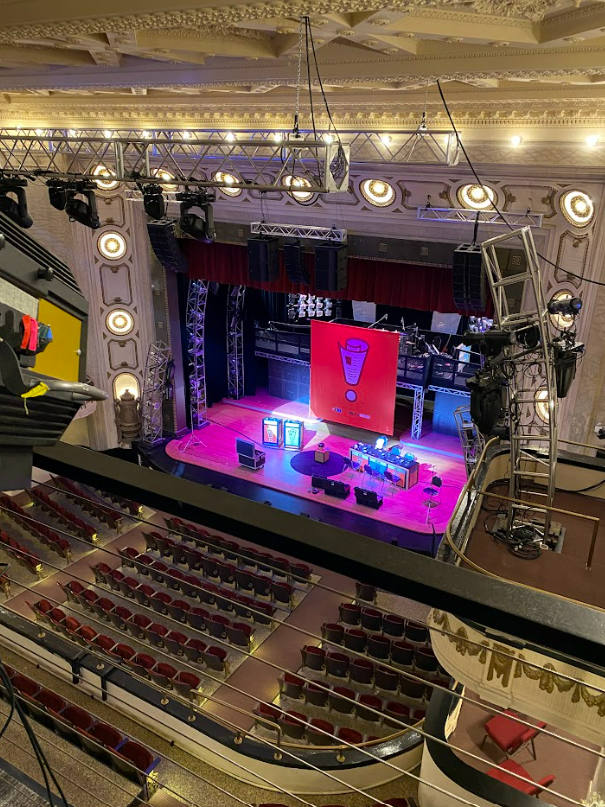
A fast and cheap birth
Recorded in front of a live audience on Thursday night and edited Friday for broadcast that weekend, “Wait Wait” has become a cherished public radio anchor show, nourished by the wry snappy patter of Sagal; the warmth and humor of the late Carl Kasell, the official judge and scorekeeper until 2014; and Kasell’s equally sagacious successor Bill Kurtis.
Regular panelists over the years have included the likes of Paula Poundstone, Tom Bodett, Bobcat Goldthwait, Roy Blount Jr., Peter Grosz, Helen Hong and numerous others, many of them comedians. It also has had numerous celebrity guest hosts. The program is heard on 741 stations by an estimated 3.1 million people, and the podcast gets 1.3 million downloads.
For such a popular radio show, “Wait Wait” had a short gestation.
“NPR said, ‘We’re going to start this new show in six weeks and you’re going to record it over at the local public radio station, which is WBEZ, and edit it and put it out for broadcast,’” recalled Lorna White.
“We had to just sort of kludge together the equipment that we had because there was no budget for this; it’s public radio.”
The program began traveling to other cities in 2000. Its first road show was at Westminster College, a small liberal arts school in Salt Lake City.
“We needed production elements,” she recalled, “so we had Carl walk around the stage with a large sign that said, ‘I’m Carl Kasell. NPR bigwigs are listening.’ We’d elicit laughs and applause so we could use them to cover edits later in the show.
“The way we do production is kind of old-school but it works for us.”
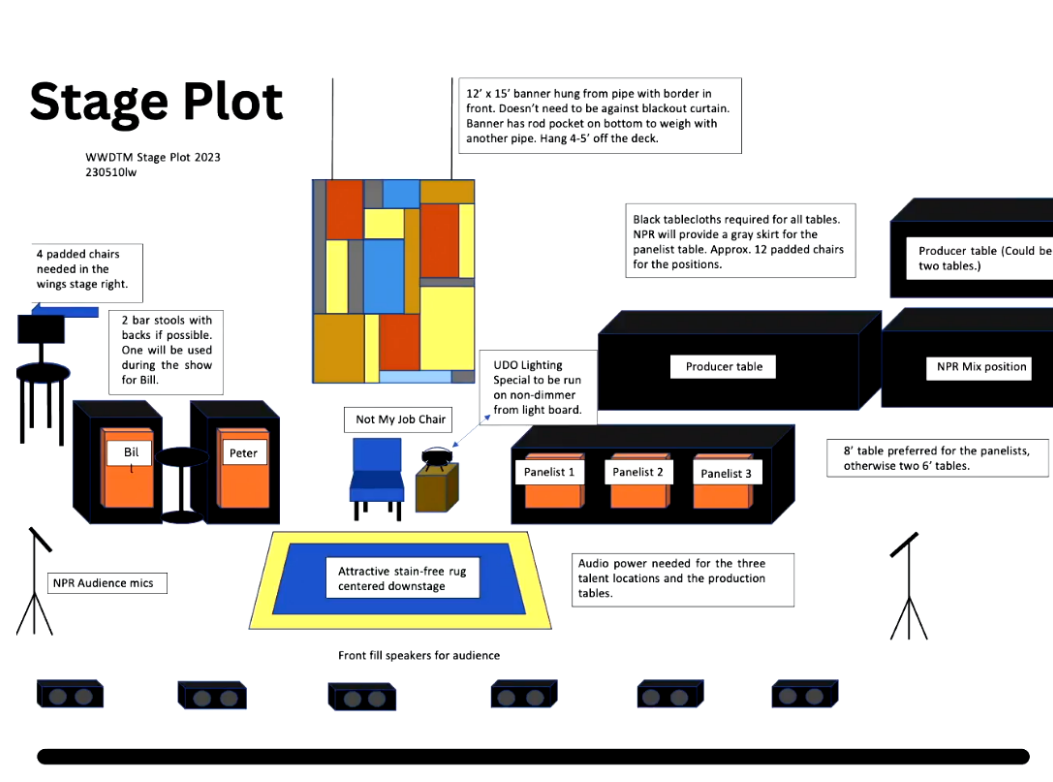
Taking the program to other markets gives NPR stations there a boost, though it’s a lot of work. “When we came to a venue — which in the early days were tiny regional theaters, a church in Baltimore, a synagogue in Boston, whatever the public radio station could find for us — we used them as fundraising shows for the station,” White said.
“They would put us in whatever venue that they could find or get on a trade. It wasn’t always ideal, but we would figure out how the show would work. … You come in, you load in, you hang in the banner, you find the tables, [then] you wait for the tablecloths. Because the tablecloths are never there and you can’t put anything on the table until there’s tablecloths.
“Sometimes we’ve gone to venues where we can’t get to the stage until afternoon,” she continued. “We usually like to hit the stage at 10 a.m. just to try to get everything plugged in before lunch at 1. Sometimes we’ve done festivals where that’s not possible. We can’t get on the stage till 2 o’clock, so we’ll set up backstage and then they’ll carry the tables out for us and we can do some fast plugging in and hope it all works that way.”
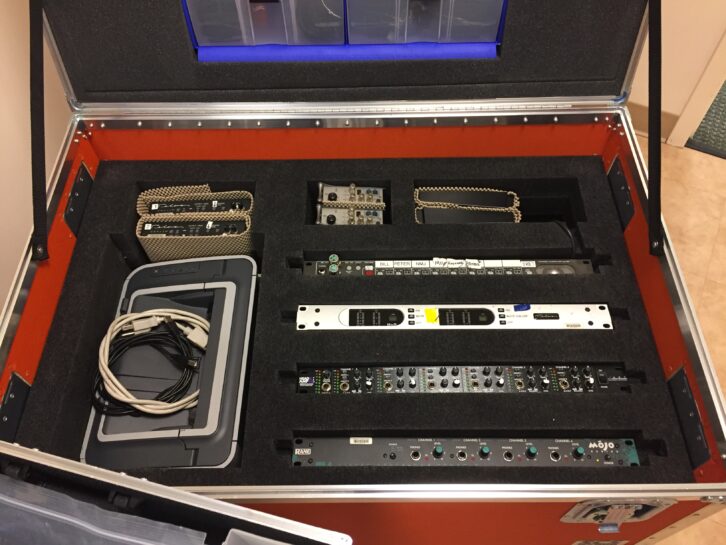
The show owns two sets of audio gear. One stays at the home theater in Chicago, and the second is shipped around the country. Even shipping the road cases of production equipment from city to city comes with risks.
“We don’t have our own truck, we don’t have a driver,” White said. “They go out by freight, and the freight company holds them for us so that we’re not doing a complete round trip every show. They’ll go from Portland, Maine, to New York City, then we just ship it onto the next place. We go out about once a month, once every four or five weeks.” She said the road cases themselves “never seem to last very long, when a forklift goes through them.”
Bialik asked if the team brings redundant equipment in case of a problem. “No, no,” Neuhaus replied. “We live dangerously.”
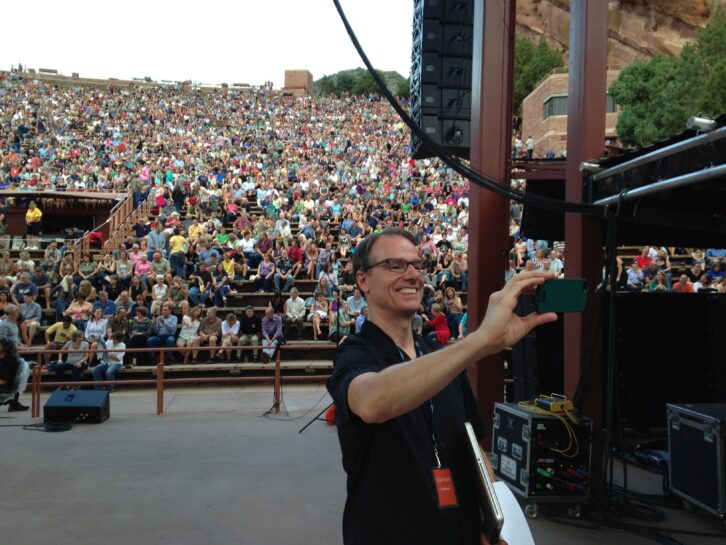
No snow here
White and Neuhaus — who report to Executive Producer Mike Danforth and are supported by about 10 others, including writers — shared a few anecdotes.
Actor Tom Hanks has had a long-time association with “Wait Wait,” even filling in for host Peter Sagal. (You can listen to his episode here. Follow the menu to the episode for Jan. 14, 2017.)
Hanks also provided support during COVID when he sat in on a Zoom recording session — though the usually talkative and witty actor didn’t say a word: “He just watched the whole show,” White recalled. And Hanks was among the celebrities who called in for Kasell’s last show (President Barack Obama was another).
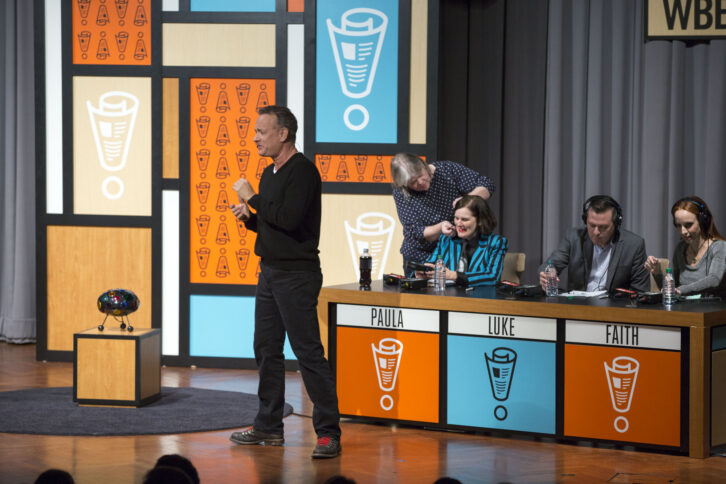
White said that the script isn’t always ready on time.
“Once we performed in Fairbanks, Alaska, and a university spokesperson announced the show before the staff was ready. Luckily Paula Poundstone was there and did a short warmup for us until everyone was in place. Then Adam Felber had to pull her off so we could start.”
Another memory involved a three-day snowfall in Chicago in February 2011, known as the Groundhog Day Blizzard. According to the National Weather Service, it was the third largest snowstorm on record for the city.
Had things gone to plan, “Wait Wait” would have been leaving the chilly Midwest for the beaches of Miami that week. Neuhaus heeded the weather warnings and flew south early, as did Sagal. But everyone else on the program staff ended up running the show from home, after the city was snowed in. But with the help of an engineer who flew in from L.A. and an NPR staffer who came down from Washington, the “Wait Wait” team managed to get two live shows recorded and edited on location.
“By Friday everybody [in Chicago] was back in the office,” said Neuhaus, who was still in Florida. “I was emailing with a producer and teasing him by saying, ‘Hey, I need to wait a minute. I’m editing out on the balcony of my hotel room and the sun is too strong.’ He replied, ‘That’s OK, I need a minute to empty my trash can onto your desk.’”
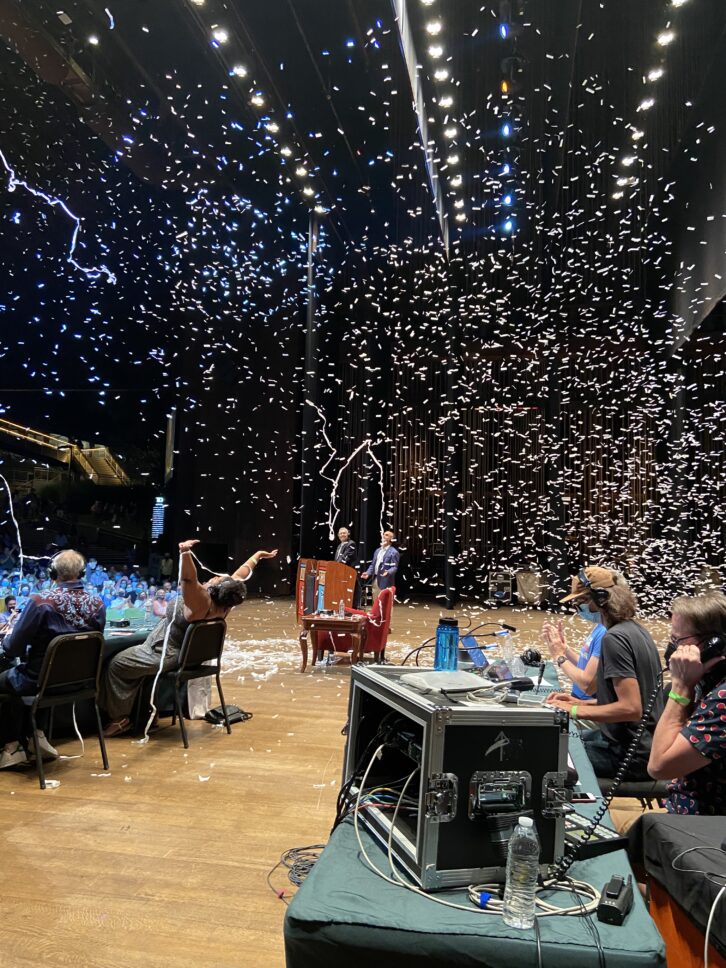
Back in the groove
After 18 months of virtual productions, “Wait Wait” returned to the in-person format with live audience with a show from the Mann Center for the Performing Arts in Philadelphia.
“It was crazy how we felt out of place,” White said, “how much we forgot, how much the backstage crew had forgotten. We just weren’t in our groove. It was great to be working like this again.”
Today, when the show isn’t traveling, it appears on stage at Chicago’s Studebaker Theater. It also has appeared in iconic venues such as Carnegie Hall and Tanglewood, though large musical venues that are acoustically very “live” can be challenging.
“We play better in theaters than in concert halls because of the resonance of the hall,” Neuhaus said. “But we adapt and we count on the staff of each venue to make it sound right.”
You can watch excerpts of the AES panel interview on Facebook video here.
The Workflow
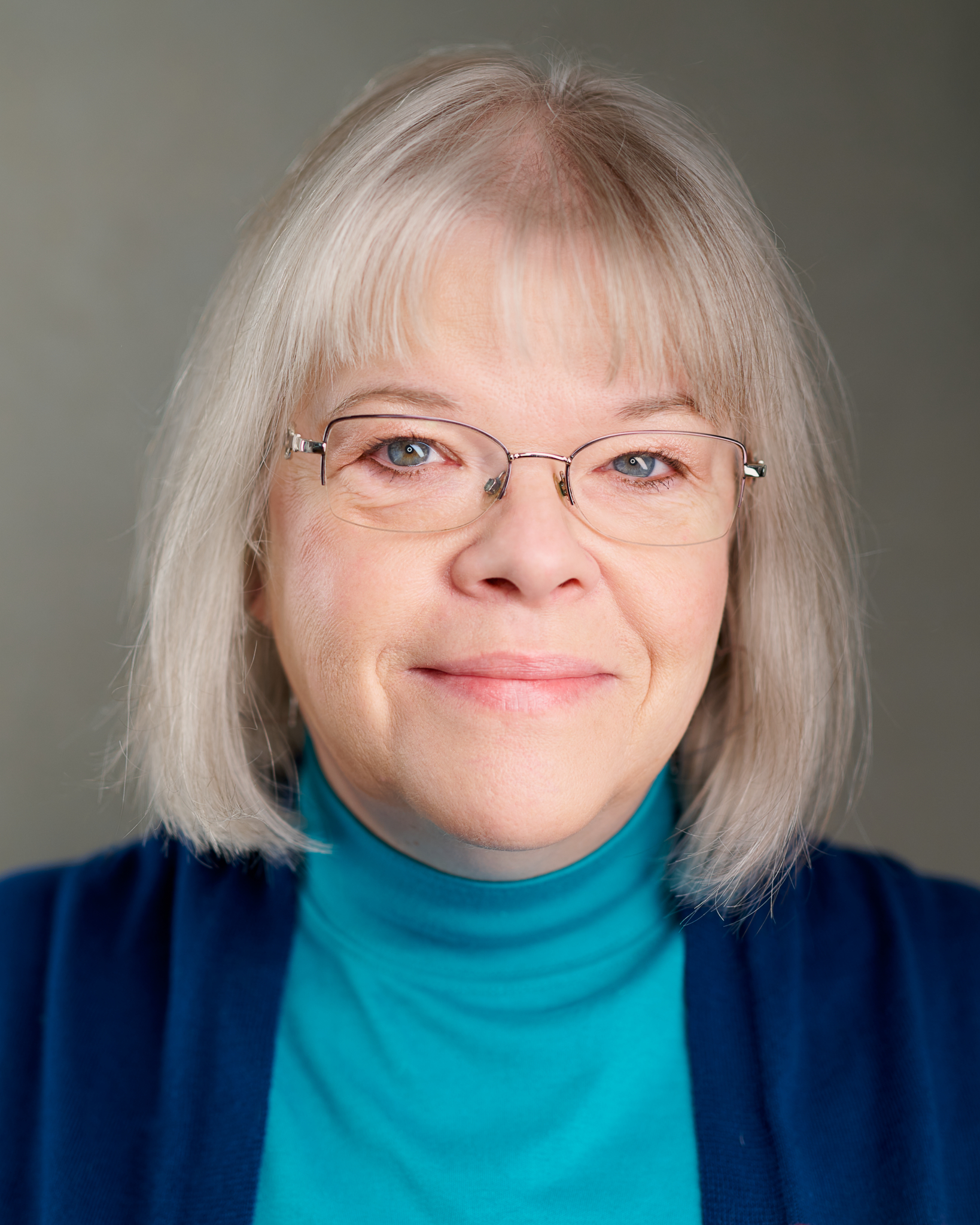
Lorna White described the program’s workflow for Radio World:
We think the audience wants to see a radio show, so for a road show we set up everything onstage, including our mix position. In our home at the Studebaker Theater in the Fine Arts Building in Chicago, we have a booth in the third balcony. FOH mixing is done by the local stage crew.
We use six omnidirectional DPA d:fine headset microphones and Sony MDR-7506 headphones instead of stage monitors. Peter Sagal wears Sensaphonics custom ear molds for his Sennheiser IE 200 earbuds (shown).
Audience reactions are captured with two Sennheiser MKH 416 microphones on stands. The audio is fed into a Midas Venice 24-channel console, along with additional sources for audio clips, sound effects and listener calls. Special guests can be onstage or brought in via Zoom and projected onto a screen so the audience can see them.
The show is mixed live to stereo and recorded onto two Sound Devices 722 recorders. The show audio files are copied onto CF cards and handed out to five staffers at the end of the night.
All post-production happens on Friday, with three producers each editing a different segment on MacBook Pros running Adobe Audition CC. Sessions and other files are shared via Hightail. Robert and I then master the broadcast and podcast, which are distributed that weekend.





